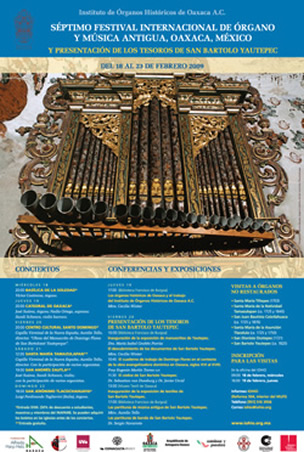
Nearly seventy organ and early music enthusiasts from five foreign countries gathered in Oaxaca this year for one of the most spectacular IOHIO festivals to date. In keeping with a tradition established since our first festival in 2001, this year´s event offered not only outstanding musical fare—six organ, chamber music and choral concerts, and two master classes by the eminent Italian organist and musicologist, Luigi Ferdinando Tagliavini--but also lectures on related topics and field trips to visit unrestored instruments. The state of Oaxaca has one of the highest concentrations of historic pipe organs in the world, and the IOHIO festivals provide a unique opportunity to see and hear them.
Sometimes the organs may lead to aspects of Oaxacan history and culture which are not directly related to the organs, but may be important enough to highlight during our festivals. Such was the case in our Fifth Festival in 2005, which celebrated the transcription and publication of a book of organ pieces, compiled by a Oaxacan nun in the 19th century, with lectures and activities related to the theme of “Music in the Convents of Mexico.”
In similar fashion, this year´s festival included a second theme, “Presentation of the Treasures of San Bartolo Yautepec,” in reference to the contents of two wooden trunks discovered in the choir loft of the San Bartolo church during a visit by the IOHIO in 2001 to register the organ. The trunks were full of religious books and manuscripts dating from the early 18th century, as well as religious and popular band music from the 19th and early 20th century. The oldest books and scores came from the Dominican seminary in Nejapa, located in southeastern Oaxaca, and one of them was backed with two sections of a prehispanic codex, the first discovered in this area of Mexico. These documents were brought to San Bartolomé Yautepeque, as the town was known in colonial times, by the seminarian and later maestro de capilla, Domingo Flores, native of San Bartolo, and there they remained for nearly 300 years.
This is not the first time that the IOHIO has discovered historical manuscripts during organ visits, but the Yautepec discovery was by far the most significant. The music from the manuscripts is largely vocal—Gregorian chant and polyphony, with some verses in zapotec--and provides a rare glimpse into a period of Dominican evangelizing in Oaxaca when the transmission and composition of sacred music was of the highest priority. 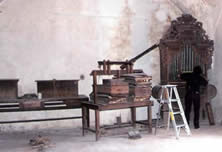
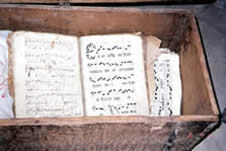
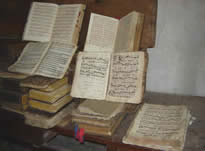
In 2007, the community of San Bartolo Yautepec allowed the documents to be brought to Oaxaca for restoration and analysis and then authorized the IOHIO and the Burgoa Library to disseminate the information through conferences and concerts during the Seventh Festival. Thanks to their interest in the project, festival participants had the opportunity to hear this music after centuries of silence in one of the most splendid 16th century venues in Mexico, the former convent of Santo Domingo de Guzmán.
February 18 The Festival started off with the first of two master classes offered by Luigi Ferdinando Tagliavini on the organ of San Jerónimo Tlacochahuaya. Since he is the world´s expert on the theme of early Italian keyboard music, this was the obvious theme of the master classes. Among the participants were professional organists from Morelia, Toluca and Queretaro, Mexico, and Sao Paolo, Brazil, as well as organ students from Oaxaca and Mexico City. In addition, nearly twenty auditors from Mexico, the USA and Canada attended the classes.
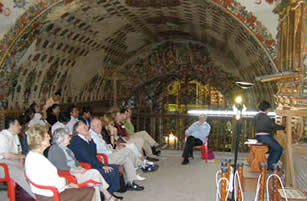

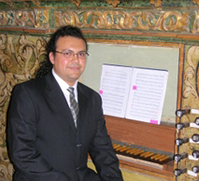
That evening in the Basílica de la Soledad, the Mexican organist Víctor Contreras presented the First Concert of the Festival, a dazzling program of works by Spanish composers of the 16th--18th centuries. The case of this elaborately decorated monumental organ bears the earliest date of any Oaxacan organ--1686
February 19 Luigi Ferndinando Tagliavini offered his second master class on early Italian organ music in Tlacochahuaya. In both sessions, the main focus was on the music of Girolamo Frescobaldi, though pieces by other Italian composers were also presented.
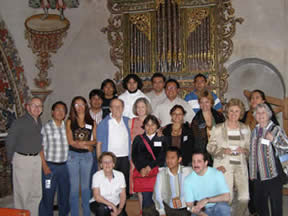
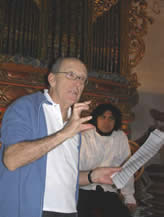
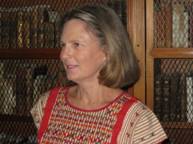
That afternoon, participants gathered in the Francisco de Burgoa Library in the Santo Domingo ex-convent for the Inauguration of the Festival by the Director Cicely Winter. Her presentation about the “Oaxacan Historic Organs and the Work of the IOHIO” included the historical antecedents of the organs, the evolution of construction techniques and decorative traditions, and the IOHIO projects to document and conserve the organs and to teach local young people to play them.
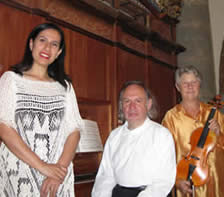
The Second Concert of the Festival took place that night in the Oaxaca Cathedral on an organ built in 1712. Mexican artists Nadia Ortega, soprano, Sandi Schwarz, violin, and José Suárez, organ, offered a program of works by Italian and German composers. The church was packed and the audience transported by the gorgeous music and elegant presentation of the ensemble.
February 20 “Presentation of the Treasures of San Bartolo Yautepec.” María Isabel Grañen Porrúa, director of the Francisco de Burgoa Library, inaugurated the exhibit “Los Baúles de Yautepec,” in reference to the wooden trunks full of documents which were found in the Yautepec church. Cicely Winter gave an introductory talk about the discovery of the manuscripts and the process of transferring them from Yautepec to the Restoration Lab of the Burgoa Library.
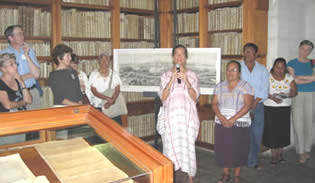
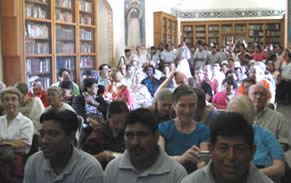
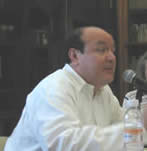
Fray Eugenio Martín Torres (Instituto Dominico de Investigaciones Históricas, Queretaro) then spoke about the workbook of seminarian Domingo Flores from Yautepec in the context of Dominican evangelizing in Oaxaca in the early 18th century.
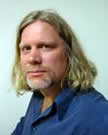
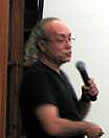
The following lecture by Javier Urcid (Brandeis University) and Sebastian van Doesburg (Academic Coordinator of the Burgoa Library) described and analyzed the two sections of a prehispanic codex which were used to back one of the books of Gregorian chant. This discovery has worldwide significance, since it is a section of only the sixth divinatory codex known in Mexico and may be the first which is zapotec and not mixtec in origin.
After the morning´s conferences, Festival participants walked down the street behind the Yautepec band “del Espíritu Santo” to the Oaxaca Textile Museum for the opening of a weaving exhibit organized in collaboration with the IOHIO festival. San Bartolo Yautepec is renowned for its exquisite huipiles, the traditional women´s garment, and fortunately the weaving technique has been preserved. Nicolasa Pascual, one of the most outstanding artisans in the community, was honored with this exhibit of her fine work.
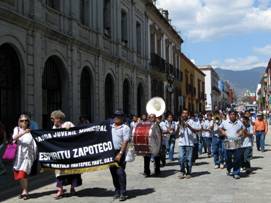
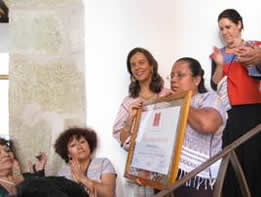
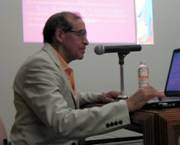
The afternoon´s conferences focused on the music manuscripts from the Yautepec trunks. Musicologist Aurelio Tello (Centro Nacional de Investigación, Documentación e Información Musical or CENIDIM) presented a detailed analysis of “The manuscripts, the books of Gregorian chant and the notebook of polyphony from San Bartolo Yautepeque, Oaxaca.”
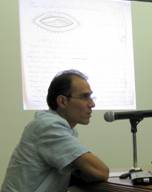
Musicologist Sergio Navarrete then spoke about the band music scores dating from the late 19th to mid-20th centuries whose dissemination and exchange among the Mixe, Chontal and Zapotec ethnic regions reflects the historic Dominican evangelizing route. Some pieces from the manuscripts were presented after his talk by the Region Mixe ("RM") band from Santa María Tlahuitoltepec (Mixe). Most arresting of all were the selections from the “Missa Prandis,” music which was appreciated, copied and distributed among the three ethnic groups more than 100 years ago and is still known to this day in some of the outlying communities. 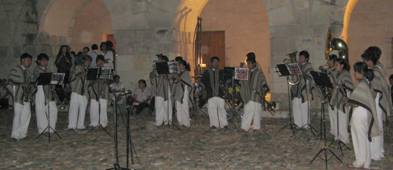
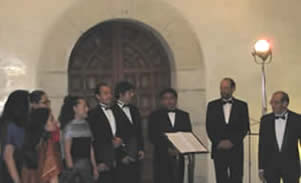 That night, the Capilla Virreinal de la Nueva España directed by Aurelio Tello presented the Third Concert of the Festival in the dramatic setting of the former convent of Santo Domingo. This stunningly beautiful concert brought back to life some of the polyphonic works, including three verses in Zapotec, from the Domingo Flores manuscript. More than 50 people from the community of San Bartolo Yautepec—municipal authorities, members of the town band, weavers, and others—were present for the entire day´s events. They were amazed by the activities generated by the contents of the wooden boxes in their church, but were especially impressed by the beauty of the music presented that evening in Santo Domingo.
That night, the Capilla Virreinal de la Nueva España directed by Aurelio Tello presented the Third Concert of the Festival in the dramatic setting of the former convent of Santo Domingo. This stunningly beautiful concert brought back to life some of the polyphonic works, including three verses in Zapotec, from the Domingo Flores manuscript. More than 50 people from the community of San Bartolo Yautepec—municipal authorities, members of the town band, weavers, and others—were present for the entire day´s events. They were amazed by the activities generated by the contents of the wooden boxes in their church, but were especially impressed by the beauty of the music presented that evening in Santo Domingo.
February 21 Our traditional all-day field trip to the Mixteca Alta began with a visit to Santa María Tiltepec. Appreciated by art historians for its richly carved facade, this 17th century church houses one of Oaxaca´s oldest organs (1703), unique in both its construction technique and decoration.
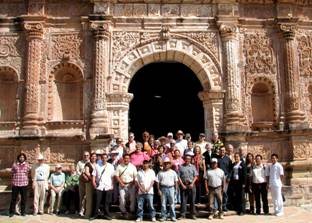
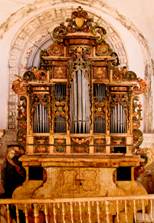
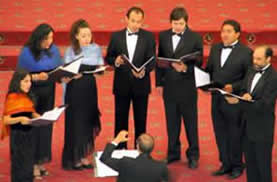 Santa María de la Natividad Tamazulapan was the site of the Fourth Concert of the Festival. The program of the Capilla Virreinal de la Nueva España directed by Aurelio Tello featured colonial music from the Americas in native languages, which was contrasted with several pieces on the processional organ located in a high side balcony overlooking the nave of the church. After the concert, the IOHIO organ scholarship students from Tamazulapan presented a short program, which was especially gratifying for the local community.
Santa María de la Natividad Tamazulapan was the site of the Fourth Concert of the Festival. The program of the Capilla Virreinal de la Nueva España directed by Aurelio Tello featured colonial music from the Americas in native languages, which was contrasted with several pieces on the processional organ located in a high side balcony overlooking the nave of the church. After the concert, the IOHIO organ scholarship students from Tamazulapan presented a short program, which was especially gratifying for the local community.
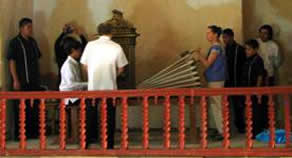
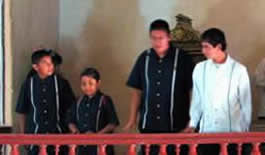
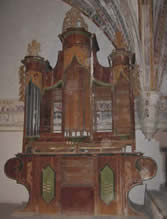
Our next stop was in San Juan Bautista Coixtlahuaca, renowned for its 16th century open chapel, church and former convent. Here we saw two unrestored organs dating from the early 18th and late 19th centuries, representing two contrasting styles of Oaxacan organbuilding: a monumental instrument built in 1876 and a small finely painted processional organ built around 1725-30 (only the exterior case remains).
.
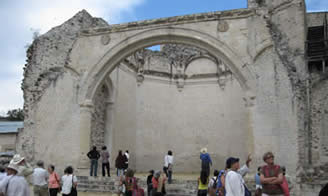
Our arrival in San Andrés Zautla for the Fifth Concert of the Festival was facilitated by the Road and Bridges Commission (CAPUFE) who every year supports our festival by opening a direct access to Zautla through the side barrier of the super highway, thus saving us an hour of travel time. The village band played Oaxacan favorites while the local women served us a delicious stew (estofado) in the patio behind the church. This concert on Zautla´s elaborately decorated organ (built in 1726) had an improvisatory character and included musicians José Suárez and Sandi Schwarz (violin), Barbara Owen, Laura Carrasco, Luigi Ferdinando Tagliavini and Cicely Winter, as well as a local scholarship student.
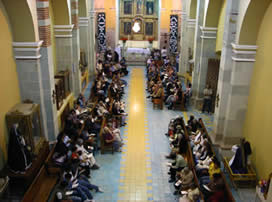
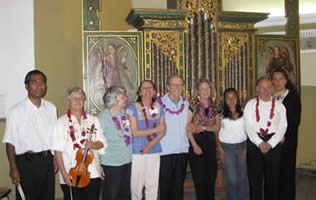
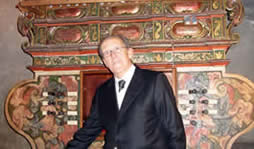 February 22 The Sixth Concert of the Festival, played by Luigi Ferdinando Tagliavini in Tlacochahuaya, was the crowning musical event of the festival. The title of his program was “Spanish, Mexican and Italian Music in parallel” and it juxtaposed repertoire on similar themes and from parallel time periods during the 16th to 18th centuries. This organ, built around 1725-1730, is highly appreciated among the Oaxacan restored instruments because of its rich sound and gorgeous case decoration, which combines with the elaborately painted church interior.
February 22 The Sixth Concert of the Festival, played by Luigi Ferdinando Tagliavini in Tlacochahuaya, was the crowning musical event of the festival. The title of his program was “Spanish, Mexican and Italian Music in parallel” and it juxtaposed repertoire on similar themes and from parallel time periods during the 16th to 18th centuries. This organ, built around 1725-1730, is highly appreciated among the Oaxacan restored instruments because of its rich sound and gorgeous case decoration, which combines with the elaborately painted church interior.
February 23 The final event of the festival was a visit to the community of San Bartolo Yautepec, whose cultural treasures had been so prominently featured throughout the festival. En route toward the Isthmus of Tehuantepec, we stopped to admire the 18th century polychromed organs in the churches of Santa María de la Asunción Tlacolula and San Dionisio Ocotepec.
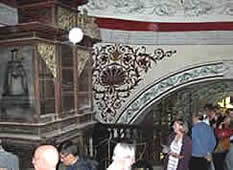


As we neared San Bartolo, we were surprised to see a crowd of people from the community fanned out across the road. The municipal authorities, members of the band, and dancers in native costume had all come to receive us officially at the entrance into their town. After the town president and the IOHIO director had exchanged words of welcome and gratitude, everyone marched along behind the band, accompanied by the whooshes and bangs of the firecrackers, to the atrium of the church.
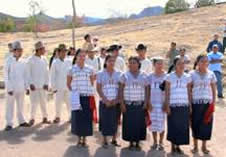

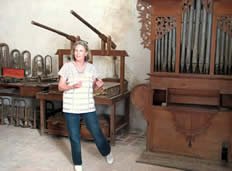
We ascended to the choir loft to see the organ and the display of antique band instruments. It was a pleasure to speak to the local people about the organ, its history, and how it worked, because most of them had never been up to the choir loft nor seen the organ before.

A delicious feast of barbecued deer (prevalent in this area) and squash seed soup had been prepared for us by the women of San Bartolo. Fortunately there was enough left over for the whole village of approximately 700 people to enjoy after we left.
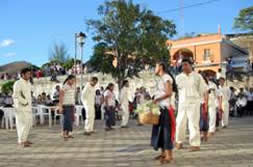
A group of young people presented a traditional pre-nuptial dance, very special and dear to this town, which had been revived and rehearsed for the occasion. The girls had even sought out the traditional wrap around skirts, no longer used, among the elderly women in the town in order to complete their costume.
The festival increased awareness in the community of San Bartolo Yautepec about its rich cultural heritage. Since then the authorities, the IOHIO and other institutions of support have been trying to reinfo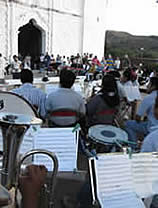 rce this initiative.
rce this initiative.
-
The band has been reorganized and motivated by their performance in Oaxaca during the festival. It is now included in a government project which replaces old instruments and provides ongoing training to local band leaders. The former director, 82 year old, had to leave his post several years ago when he could no longer see, and thus began the disintegration of the band. But thanks to the support of the Alfredo Harp Helú Foundation and the initiative of the IOHIO, he had cataract surgery on both eyes and recovered his vision. He is now back at work with the band, as an advisor to the present director.
-
The community is interested in reviving the native language, a dialect of Zapotec, which is now spoken only by the elderly. The authorities have been negotiating with the teachers to set aside time during the school day for the native speakers to teach the young people.
We were told later that some of the neighboring towns had expressed regret that they no longer had an organ, once they became aware of all the attention and benefits which San Bartolo´s non-functioning instrument had engendered. We hope that the word will continue to spread about the experience of this particular community and inspire others not only to take the initiative to recover and preserve their traditional culture, but also to report other undocumented organs.
The IOHIO Festivals highlight two very different aspects of the Oaxacan historic organs. While the restored instruments may transmit the most sophisticated music from the European art tradition, all the organs, particularly those which no longer function, may also connect us to the history and traditional culture of the communities in which they are located. Since the surviving organs in Oaxaca are still located in their original churches, it is not possible, nor is it desirable, to separate them from their present cultural context.
The IOHIO is grateful for the support of the following institutions:
Fundación Alfredo Harp Helú Oaxaca A.C
Instituto Nacional de Antropología e Historia (INAH)
Arquidiócesis de Antequera Oaxaca
Secretaría de Cultura del Gobierno del Estado de Oaxaca
Instituto Italiano de Cultura
Universidad de Valladolid, España
Biblioteca Francisco de Burgoa
Centro Cultural Santo Domingo
Caminos y Puentes Federales (CAPUFE)
We are also grateful for the support of the following Oaxacan businesses:
Hotel Anturios
Hotel Casa Arnel
Hotel de la Parra
Hotel Marqués del Valle
Hotel Parador San Agustín
Hotel Principal
Hospedería La Reja
Hostal de la Noria
Proveedora Gráfica de Oaxaca

